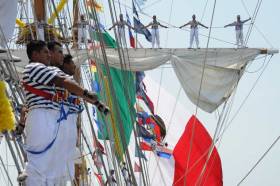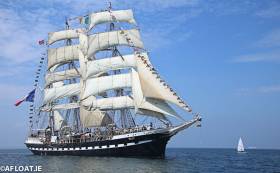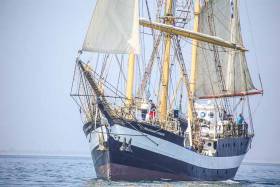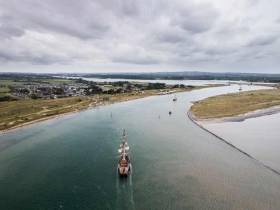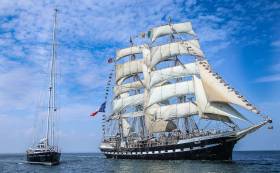Displaying items by tag: Tall Ships
Mexican Tall Ship is Dublin Port Bound
Dublin Port Company and the Mexican Embassy in Dublin have announced that one of the world’s largest Tall Ships, the 270-foot-long Cuauhtémoc will sail into Dublin on Thursday, 5th September 2019 for a five-day visit to the capital before departing again on 10th September 2019.
The majestic vessel will be met by Dublin Port’s tugboats Shackleton and Beaufort in a ceremonial escort to mark the ship’s arrival in Dublin Bay next Thursday, accompanying her to Sir John Rogerson’s Quay where she is due to berth at 11am.
Arriving from Hamburg, Dublin is the second-last stop on the ship’s 250-day training voyage of Northern Europe involving visits to 15 ports in 10 different countries (Canada, United Kingdom, France, Netherlands, Denmark, Norway, Germany, Ireland, Spain and Colombia).
Led by Commanding Officer Captain Carlos Gorraez Meraz, the Cuauhtémoc is an official sail training vessel of the Mexican Navy which travels around the world carrying a message of friendship and goodwill. This will be the Cuauhtémoc’s fifth visit to Irish waters since her maiden call in 1998. She subsequently visited the capital in 2008, in 2012 as part of the Tall Ships festival and again in 2015.
In keeping with the tradition of hospitality and friendship, the Cuauhtémoc will be open to the general public to visit, for free, on the following dates and times:
- Friday, 6th September, from 11.00am to 8.00pm
- Saturday 7th September, from 11.00am to 8.00pm
- Sunday 8th September, from 11.00am to 8.00pm
- Monday 9th September, from 11.00am to 8.00pm
Members of the public will be able to see up close members of the 257-strong crew at work and inspect the fine craftsmanship of the vessel which has trained more than thirty generations of officers, cadets, petty officers and sailors, both Mexican and other nationalities.
Commenting ahead of the tall ship’s visit, The Ambassador of Mexico to Ireland, H.E. Miguel Malfavón said; “For over 40 years, Mexico has enjoyed excellent diplomatic relations with Ireland built on a shared sense of history and strengthening cultural, academic and trading ties in the present day. The arrival of the Cuauhtémoc reminds us of the affinity and friendship that exists between our two nations and symbolises the hand of friendship from Mexico to Ireland. For most of the crew on board, it will be their first visit to Ireland, marking a new generation of Mexican-Irish exchange.”
Encouraging members of the public to visit over the weekend, Eamonn O’Reilly, Chief Executive, Dublin Port Company, said; “Tall Ship visits to Dublin are always a highlight, and the Cuauhtémoc is no exception. This is a spectacular vessel and one of the finest working tall ships at sea today. I would encourage people in the city to take a trip down to Sir John Rogerson’s Quay and explore the Cuauhtémoc over the weekend. She brings a little piece of Mexico to our doorstep and it’s an opportunity not to be missed.”
Built in the Celaya shipyards in Bilbao, Spain, the Cuauhtémoc was launched in July 1982. She was the last of four windjammers built by Bilbao shipyards and is named after the last Aztec Emperor who was imprisoned and executed by the conquistador, Hernán Cortés, in 1525.
Lord Mayor John Sheehan, County Mayor Christopher O’Sullivan, and Brendan Keating, CEO, Port of Cork today welcomed the Irish vessel Brian Boru and the Tall Ships Pelican of London and Maybe into the Port of Cork. The three ships having completed voyages as part of the Cork Sail Training Bursary Scheme 2019 included 50 young people onboard as trainees.
A presentation ceremony also took place in the Port of Cork to celebrate the achievement of 25 young people from all backgrounds and a range of abilities across Cork City and County who completed voyages aboard the Irish vessel Brian Boru and the Tall Ship Pelican of London during the 2019 season. These voyages were made possible by a group of generous sponsors including Port of Cork, Cork City Council, Cork County Council, Ardmore Shipping, and The Institute of Master Mariners.
Five trainees from the City and County crewed the Pelican on voyages from Belfast to Liverpool and on to Dublin. These trainees formed part of groups with up to 28 trainees and mentors on each voyage, which were part-funded using EU “Erasmus +” funding and involved active educational programmes of youth sailing development as part of “Youth Exchange” projects.
In addition, eight Cork-based young people took part on the Asgard Armada voyages aboard Pelican and Maybe sailing in convoy with Brian Boru and arriving alongside in Cork today.
The Cork Sail Training Bursary Scheme was established in 2014 to provide access to Sail Training voyages on tall ships and large sailing vessels for young people from the region. Now in its sixth year, the scheme is one of the largest and most active on the Island of Ireland and runs in parallel with similar schemes now in operation under Sail Training Ireland in Belfast, Drogheda, Dublin, Waterford, Derry and Arklow. The participants are nominated through a network of youth and community groups in Cork and places are available to young people from all backgrounds and with all abilities. The scheme has supported approximately 140 trainees since 2014 and looks likely to grow from strength to strength over the coming years.
“It’s fantastic to see the impact these sail training voyages can have on the young participants. It can lead to a real transformation and in such a short period of time” Daragh Sheridan, Sail Training Ireland.
Speaking at the presentation ceremony, Brendan Keating Chief Executive of the Port of Cork said: ‘We are proud to support these sail training voyages which give young adults an opportunity which some have described as life-changing. Not only do they learn how to sail and skipper these fantastic vessels, they are taught personal development and become better equipped to deal with challenges, not just at sea but later in their everyday lives. Well done to all the sail trainees this year.’
The certificates were presented to trainees by Lord Mayor of Cork City John Sheehan and County Mayor Christopher O’Sullivan.
Young Adventurers Set Sail on the 'Asgard' Armada Tall Ship Voyage
Today, 50 young people from all over Ireland head off on a ten-day voyage aboard three Tall Ships, the Pelican of London, Maybe and Brian Boru. The participants were offered the amazing opportunity to become trainees on a tall ship to experience an exciting voyage leaving Dublin, visiting Wales and finishing up in Cork on the 23rd August 2019. This opportunity was made possible by funding support from the Government of Ireland through the Department of Defence, Dublin City Council and Dublin Port Company.
This is the inaugural Asgard Armada Sail Training Voyage. The project will see twenty-eight 15-17-year olds and twenty-two 18-30-year-olds from all backgrounds and abilities becoming trainee crew members aboard the ships. Skills such as communication, leadership, confidence and teamwork are all developed when onboard a sail training vessel. A key aim is to see a percentage of trainees progressing onto mentoring roles, new employment and other training opportunities.
Trainees were selected by nominating organisations currently working with young people throughout the country, such as the HSE, Cork Life Centre, Educational Training Boards, Manor St John Youth Services, Irish National Organisation for the Unemployed, Foroige, Peter McVerry Trust, Youth Reach, Scouts and Girl Guides.
“We are delighted that this project involves the three ships sailing in convoy, which adds to the adventure for trainees. It is fantastic to provide this opportunity to young people who may not otherwise have had a chance like this” Daragh Sheridan, CEO of Sail Training Ireland.
Tall ships are the ultimate symbols of seafaring romance, inspiring enthusiasm in maritime fans of all ages. Four of these majestic ships will come to Hamburg for the 830th Hamburg Port Anniversary from 10 to 12 May – Alexander von Humboldt II, Kruzenshtern, Sedov and Mir. They will participate in the grand arrival and departure parades in the heart of the city, on the Friday and Sunday respectively, and invite visitors to look around on board. Alongside these amazing tall ships, the Hamburg Port Anniversary will be a meeting place for some 300 vessels of all kinds, including many classic sailing vessels that will also be open to visitors.
Germany’s first female captain on a tall ship
The Alexander von Humboldt II is currently Germany’s largest operational sail training ship, with length overall 66 metres. She is a three-masted barque, launched in Bremen in 2011 as the successor to Alexander von Humboldt, and belongs to the non-profit foundation Deutsche Stiftung Sail Training. She has a regular crew of 25, and provides places for up to 55 trainees, who pay for the trip and to learn the fundamental skills of sailing. All of them, from trainees to helmsman, will be under the command of Maren Reif, Germany’s first female captain of a tall ship.
Maren Reif was a trainee on the Alexander von Humboldt for the first time in 2003. That was a life-changing experience for her – “the trip from Travemünde through the Bay of Biscay to Lisbon was so exciting that I then decided to give up my job as a communication designer and took up nautical studies,” she explains. After completing her studies, Maren Reif joined a Hamburg shipping company, obtained her sea captain’s licence, and works as a maritime inspector today.
The regular crew is made up of volunteers
Ever since qualifying as an ordinary seaman in 2004, Maren Reif has been a regular crew member on the tall ship, and since 2011 she continued on the successor vessel Alexander von Humboldt II, gaining experience in almost every position up to that of captain. “In sailing it is not so much a question of the destination, but rather the way to get there, and cooperation among the crew,” she explains. The regular crew members on the Alexander von Humboldt II do not get paid. “All of us in the regular crew are volunteers, and work for our passage. Most of us even take holidays to enable us to work on board.”
Maren Reif has chosen Hamburg as her home, and is specially pleased to come to her first Hamburg Port Anniversary as Captain of the Alexander von Humboldt II – “It is a great feeling to be part of this fantastic event, and to welcome so many interested visitors on board. It makes you aware of the close links between the people of Hamburg and their port. And it is a good opportunity to show my family, friends and colleagues around the ship. This is practically my second home,” says Maren Reif. Her personal programme highlight at the world’s greatest port festival is the tugboat ballet. “From our berth, we have a full view of the dancing tug boats. That’s really spectacular. And I’m looking forward to my first Captains Dinner on board the Rickmer Rickmers.”
The most beautiful tall ship – Kruzenshtern
Alongside Alexander von Humboldt II, three Russian tall ships will be present at the HAMBURG PORT ANNIVERSARY. Kruzenshtern is the last of the Flying-P liners of the Hamburg company F. Laeisz still in operation. She is regarded as the world’s most beautiful tall ship, with her characteristic black-and-white hull markings. This four-masted barque was launched in Bremerhaven in 1926 as Padua, and carried cargoes to South America and Australia. After the Second World War, she was surrendered to the USSR as war reparation, and renamed Kruzenshtern. Today the 114-metre traditional sailing ship is used by the Russian Ministry of Fisheries to train crews for the fishing fleet.
The longest tall ship – Sedov
With length overall 117 metres, Sedov is the world’s longest traditional sailing ship still in operation. This four-masted barque was launched at the Krupp-Germania shipyard in Kiel in 1921, under the name Magdalene Vinnen II. At the end of 1945 she was likewise surrendered to the USSR as reparation, and has been in service with the Soviet and subsequently the Russian Navy as a sail training ship for cadets. Since 2017 she has been owned by the Kaliningrad State Technical University. In 2005 Sedov was used for a major TV drama “The Loss of the Pamir”. Her white bow was painted black specially for the film.
The biggest tall ship – Mir
Mir earned her reputation as the world’s fastest tall ship in numerous tall ship races, particularly in the 1990s. The 108-metre three-masted, full-rigged ship was built at the Lenin Shipyard in Gdansk in 1987. She is owned by the Admiral Makarow State Maritime Academy in Saint Petersburg, which operates Mir as its main sail training vessel for the Russian merchant navy. Mir has for many years been a regular guest at the world’s greatest port festival.
Drogheda Teens Among Sail Training Awardees
Last Saturday, (2nd February) Sail Training Ireland held their Annual Awards event at the Mansion House in Dublin. The annual awards, as reported by Afloat.ie here recognise excellence, achievement and outstanding contribution in the sailing community at all levels. The Drogheda Sail Training Bursary has been a central element in the award ceremony for a number of years and two special recognition awards are made to Drogheda Trainees who participate in the local scheme.
Two specially commissioned perpetual trophies are awarded each year at the prestigious award ceremony. Mayor of Drogheda, Frank Godfrey and the Lord Mayor of Dublin Nial Ring were in attendance among other regional and national dignitaries to mark the occasion.
The 2018 trainees included young people from residential care homes, Garda Diversion Projects, Sea Scouts, Youth and Community groups and Schools, drug rehabilitation programmes, asylum seekers and immigrants and young people with visual, hearing and physical impairments from across the island of Ireland.
Two award recipients were Drogheda teens, Shauna Murphy of the Sacred Heart School and Sinead O’Byrne of the Grammar School. Drogheda Mayor Frank Godfrey and Drogheda Port Company Director Ciaran Callan presented the girls with a perpetual trophy each for ‘Outstanding Trainee’ on their respective voyages as part of the 2018 Drogheda Sail Training Bursary. Both of these transition year trainees displayed remarkable resilience and never refused a chance to acquire new skills and gain a greater self-belief.
"Drogheda Sail Training Bursary has funded over 100 local trainees"
Sail Training Ireland’s chairman Seamus Mc Loughlin singled out the ‘Drogheda Sail Training Bursary’ as the very first regional sail training scheme, which since 2013 has funded over 100 local trainees to participate in sail training voyages and bring a positive focus back to the maritime town of Drogheda and its famous River Boyne. Nessa Lally of Drogheda Port thanked the Mayor of Drogheda for his attendance and she emphasised the importance and the strong continued support of the Drogheda bursary sponsors, who are; Irish Cement, Fast Terminals, Louth County Council and Drogheda Port Company.
The Drogheda Sail Training Bursary programme for 2019 is now open, voyages are open to 18-23-year-olds from any nominating schools, youth or community groups, diversion projects and others. If you are seeking a life-changing experience and think you could benefit from this wonderful opportunity please get in touch as we are funding 20 trainee places this year.
Tall Ship Awards Ceremony & Launch Held in Dublin
On Saturday 2nd February 2019, Sail Training Ireland held their 7th Annual Prize Giving and Season Launch event at the Mansion House in Dublin, courtesy of Lord Mayor of Dublin Nial Ring.
As previously reported by Afloat.ie, the event at the Mansion House saw awards presented to trainees, who made an outstanding contribution to their individual voyages and to the charity.
Sail Training Ireland helps young people from all backgrounds and abilities to participate on training and self-development programmes on Tall Ships.
Their work has resulted in two thousand young people going to sea since 2011. In 2018 over 340 trainees went onboard ships from Ireland and across Europe. Minister Paul Kehoe recently announced Government funding for the charity, which will enable it to make the opportunity available to even greater numbers of young people.
"Minister Paul Kehoe recently announced Government funding for the charity"
The 2018 trainees included young people from residential care homes, Garda Diversion Projects, Sea Scouts, Youth and Community groups and Schools, drug rehabilitation programmes, asylum seekers and immigrants and young people with visual, hearing and physical impairments from across Ireland and Northern Ireland. The purpose of the sail training experience is to provide the opportunity for a change in direction, perspective, attitude, and behaviour leading to self-confidence, motivation and new skills acquired.
The highlight of 2019 will be the second running of the North East Inner City (NEIC) sail training project.
The charity is also delighted to be involved once again with “The Voyage” an initiative between the Cities of Dublin, Belfast and Liverpool which, includes voyages between the three cities. The project celebrates the historical, cultural, and maritime links between the cities. These voyages benefit from E.U. Erasmus + funding.
Sail Training Ireland announced a voyage programme for 2019 including several very exciting funded programmes. The regional sail training schemes in Drogheda, Cork, Dublin, Belfast, Waterford and, Derry, are well established at this stage and 2019 will see similar schemes starting in Arklow and the Islands. This year will also see 4 wheelchair users go on board the tall ship Lord Nelson as part of the Ability Voyage project. Lord Nelson is a ship built specifically to cater to those with disabilities. Sail Training Ireland was recently a runner up in The National Inclusion Awards in recognition of the 86 trainees with a disability that participated in 2018.
Dublin City Council and Dublin Port Company continue to support the charity and will build on the legacy of Tall Ships Regatta of 2018.
Do you want to join us and be part of an unforgettable experience and help raise funds for Spinal Injuries Ireland? This is an adventure not to be missed.
May 2019 Spinal Injuries Ireland is embarking on their inaugural Tall Ships Challenge; their flagship, fully inclusive, fundraising challenge in aid of Spinal Injuries Ireland’s services. Lead by Ireland’s most decorated Paralympian athlete, John Twomey, Spinal Injuries Ireland is setting sail on an exciting and fully-inclusive expedition.
Spinal Injuries Ireland is putting a call out for people to join their SII Tall Ship crew this May. All participants will have an experience of a lifetime and can feel great in the knowledge that their participation will also enable support and services for the over 1900 people in Ireland who have suffered a spinal cord injury. It’s a chance to become part of a unique crew whom together will prove that anything is possible.
"On this ship, everyone is given the respect, space and tools to achieve their personal and team goals. All that’s needed is determination"
John Twomey will take the helm with the SII crew of 6 people with spinal cord injuries, their 6 assistants, and 18 able-bodied people, sailing from John’s native Cork to Southampton, circling the Jurassic Coast and the Isle of Wight over 6 days. The voyage will take place aboard the ‘Lord Nelson’ Tall Ship; a specially designed fully accessible vessel. The facilities on Lord Nelson make it possible for each crew member to learn and work together equally regardless of ability. There will be no passengers onboard; everyone is a crew member. Each person will have their own role to play on the team with no assumptions made about ability. On this ship, everyone is given the respect, space and tools to achieve their personal and team goals. All that’s needed is determination.
Crewing the Tall Ship will mean full participation in a thrilling experience which is certain to impart a new belief in each person’s own abilities. The SII Tall Ships Challenge is an opportunity to say yes to adventure, yes to teamwork and yes to pushing yourself further than even you can imagine.
Each crew member will need to fundraise €3000 in the run-up to the event. Assistants costs will, however, be covered.
All funds will go to services provided by Spinal Injuries Ireland.
Fundraisers will receive a fundraiser’s info pack and will be supported with advice and tips on how to fundraise.
The sailing will take place from May 22nd to May 27th, 2019
As part of the crew, a doctor will be present and on call along with trained sailing instructors.
Sponsorship opportunities are available to companies who wish to support individual crew members or the team as a whole.
Closing date for participation is April 1st, 2019. More here.
Twenty four deaf and hearing impaired students along with four aided communicators from around Ireland have set out on the adventure of a lifetime on a 6-day Sail Training voyage aboard the Tall Ship Pelican of London.
The voyage organised by Sail Training Ireland follows on from a successful one day “taster” voyage held in 2017 for students from the Holy Family School for the Deaf in Cabra. This taster resulted in a request from the school to expand the scope of the voyage to include young people from all over Ireland. As a result, schools and deaf organisations have nominated their pupils as trainees on the upcoming voyage. The voyage will leave Dublin Port and sail around the Isle of Man and the Irish Sea before returning to Dublin.
Participating in this voyage involves the “Trainees” becoming part of the working crew. This experience provides an excellent environment for personal and social development. It is not so much learning to sail as learning from the vessel, crewmates, the sea and perhaps most importantly from the person themselves as they push themselves beyond their comfort zone. It is a medium for education outside the classroom, a non-formal approach where the emphasis is on facilitating learning through experience. A trainee’s first voyage often proves to be a turning point in their lives.
“We are delighted that so many deaf and hearing-impaired students have taken up the challenge of a tall ship adventure” said Sail Training Ireland CEO Daragh Sheridan
It is hoped that this voyage will become an annual event.
Ships Set Sail from Irish Maritime Festival in Drogheda Port
It’s as if it were a mirage. For the last three days, Drogheda’s Town Quays have been lined with four Tall Ships, tugs, lifeboats and yachts while Tom Roe’s Point hosted three French Naval Vessels. For one weekend every year, Drogheda’s busy working port is converted into a festival site and is festooned with colour and buzzes with excitement. The annual Irish Maritime Festival runs from Friday to Sunday and by Monday morning, it has all disappeared and Drogheda Port returns to business as usual.
The visiting vessels mustered at the mouth of the Boyne before noon on Friday and what followed was a beautiful parade of sail.
The banks of the Boyne were lined with people of all ages waiting to welcome the ships. Social media in the region was flooded with images of the river and the ships with people wanting to share the experience.
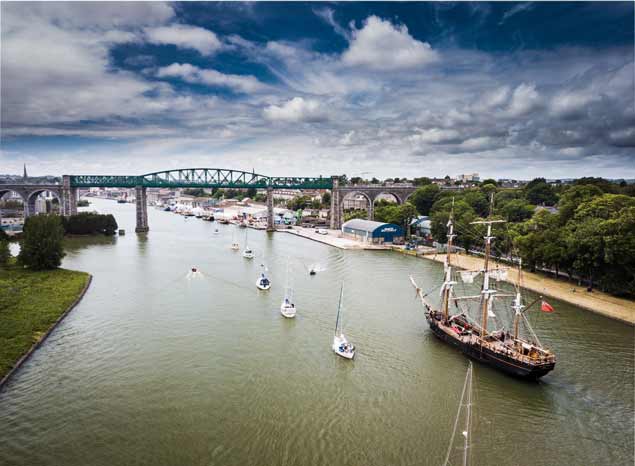 Parade of Sail at the Viaduct at Drogheda Port
Parade of Sail at the Viaduct at Drogheda Port
Friday night saw the deck of the Earl of Pembroke transformed into a stage for the Stowaway Sessions. The intimate sold-out gig featured Eve Belle and The Lost Brothers performing to 100 lucky guests at sunset with the Boyne Viaduct as the backdrop. The format was repeated on Saturday night to another 100 guests with Pilgrim St supporting headliner Declan O’Rourke.
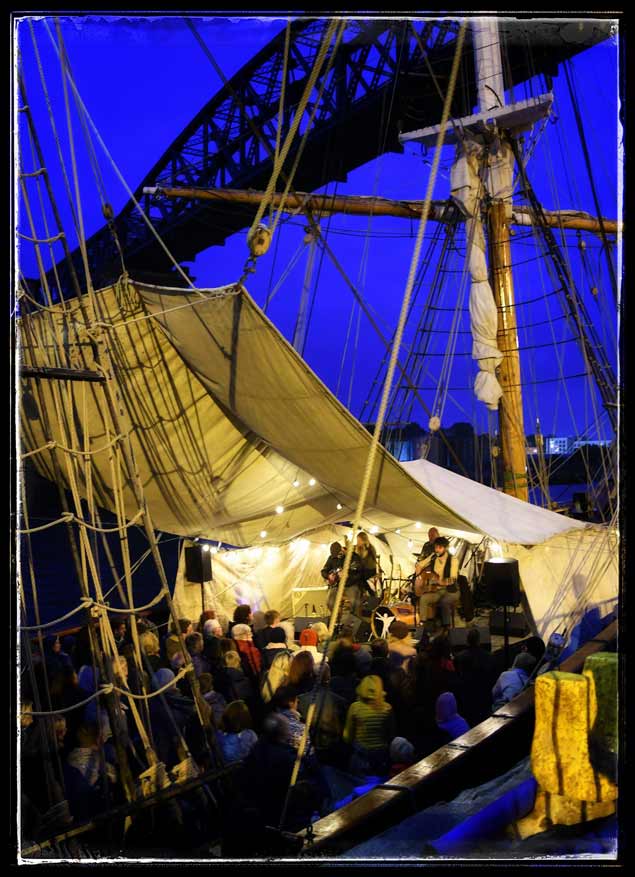 The Stowaway Sessions
The Stowaway Sessions


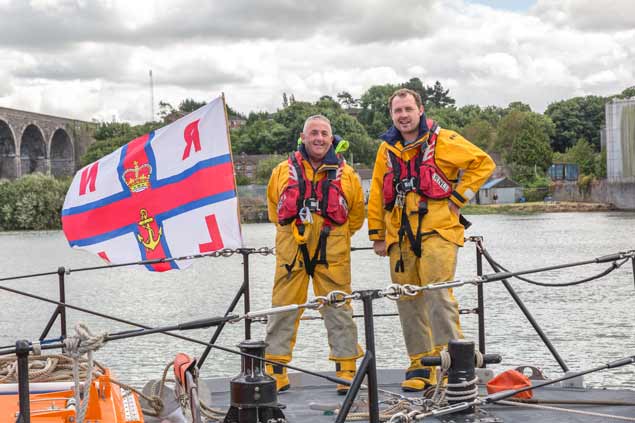

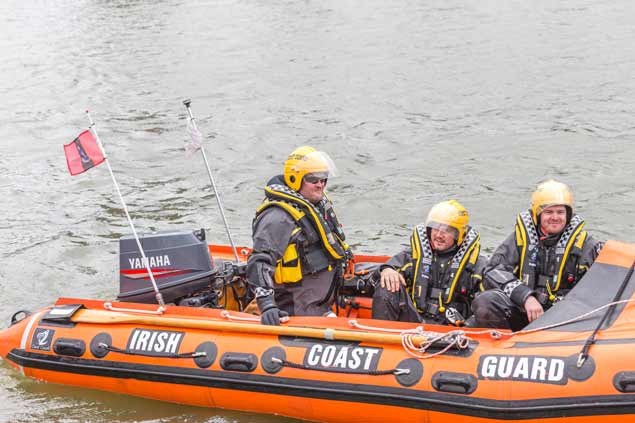

The festival proper, hosted by Louth County Council and Drogheda Port Company, kicked off on Saturday morning with visits to all of the ships inc. The Phoenix, The Earl of Pembroke, The Johanna Lucretia, The Brian Boru and the beloved motor tug Brocklebank. Crews happily welcomed visitors aboard and told the stories of each of the respective vessels. An Irish Coast Guard helicopter flyover caused surprise and delight all round.
On-shore the festival offered 2 live music stages, artisan local food and loads of family-friendly activities. The Maritime Education Zone included displays by The Irish Coastguard, Inland Waterways Ireland, RNLI, Seastainability, Education through Recreation, Boyne Boats and the Irish Power Kite and Sand Yachts.
 Sand yachts were on display
Sand yachts were on display
The Water Wags sailed by on Saturday morning on a visit to the historic Oldbridge House, mooring at the lock gates of the Boyne Canal. After being obsolete for over 80 years, the Boyne Canal is being painstakingly and beautifully restored by the volunteers of the Inland Waterways Association Boyne Navigation Branch. Following their visit to Oldbridge, the Water Wags delighted festival goers with a display on the water on Saturday afternoon.
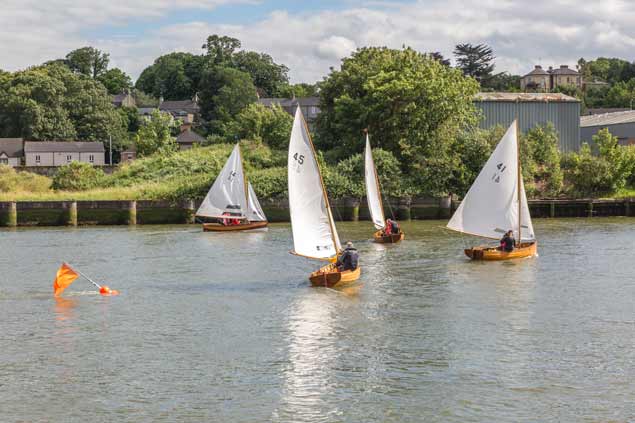 Water Wag racing on the Boyne
Water Wag racing on the Boyne
Over 200 participants in the annual Boyne Swim competed for glory on Saturday afternoon. The 2.7km course starts at Mell, passes the Irish Maritime Festival site at Drogheda Port and concludes at the Boyne Fisherman’s Rescue. The 2018 winner was Isaac Fitzmaurice finishing in 32 minutes and 23 seconds. The other winners were Colin Lowth (32 minutes and 52 seconds, male, wetsuits category), Rosie Giglia (37 minutes and 12 seconds, female, skins category) and Lauren Archer (37 minutes and 21 seconds, female, wetsuit category). The competition was fierce with a mere 29 seconds between the male first and second place and just 9 seconds between the female first and second.
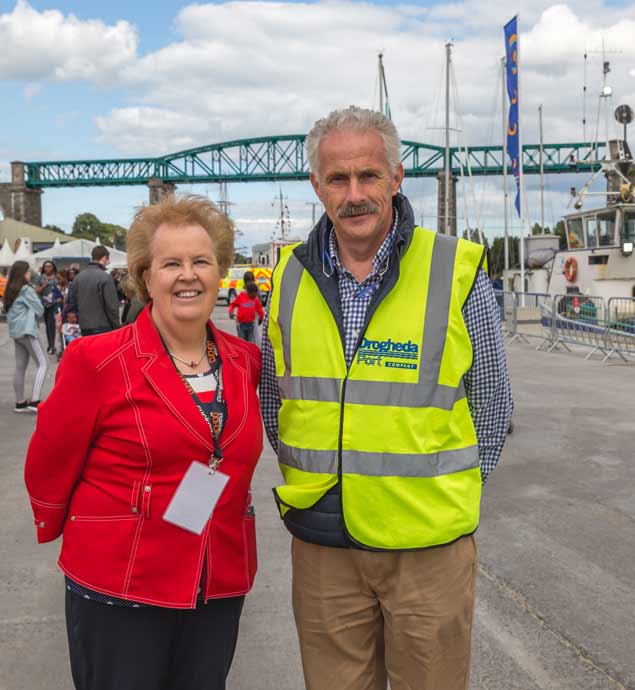 The Festival's Colette Moss and Capt Martin Donnelly of Drogheda Port
The Festival's Colette Moss and Capt Martin Donnelly of Drogheda Port
The Boyne was a hive of activity both days with the rescue services and lifeboats on the river throughout. The Howth-Drogheda Yacht Regatta saw yachts racing up the Boyne on Saturday afternoon, mooring for the weekend at Drogheda’s Fiddle Case Pier, opened in June 2017.
After the Festival Gates closed for the day on Saturday evening, the Mariners Shindig saw 200+ visiting crews enjoy dinner, drinks and live music on the Port. The late night was followed by an early start as Piper Paul McGowan visited the Port at 08.00hrs to rouse everyone from their slumber. He led a procession to the Mission to Seafarers Church (St. Peter’s Church of Ireland) for a beautiful service.
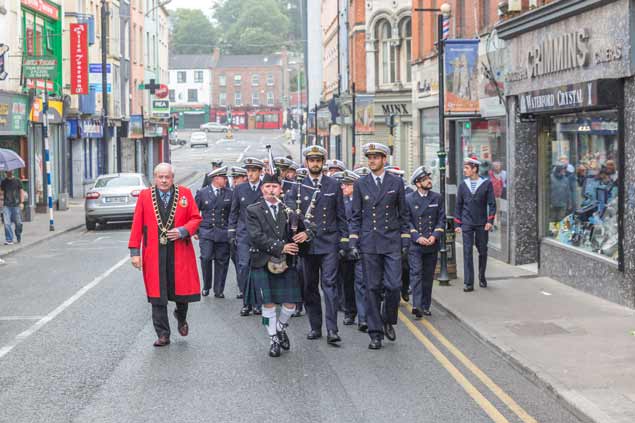 (Above and below) The Mission-to-Seafarers March at Drogheda Port
(Above and below) The Mission-to-Seafarers March at Drogheda Port

It was followed by official presentations to the French Navy by Mayor of Drogheda Cllr. Frank Godfrey on behalf of Louth County Council and Drogheda Port.
The final day of the festival started with drizzle but soon cleared to be a bright dry day and families flocked to the festival to enjoy all it had to offer. Visits to the 3 French Minesweepers, M770 Antares, M771 Altair and M772 Aldebaran were hugely popular, over-subscribed on both days. On Sunday afternoon, to mark the first visit of the French Navy to Drogheda, the Alliance Francais choir sang on the deck of The Phoenix.
 (Above and below) French Navy visitors to Drogheda
(Above and below) French Navy visitors to Drogheda
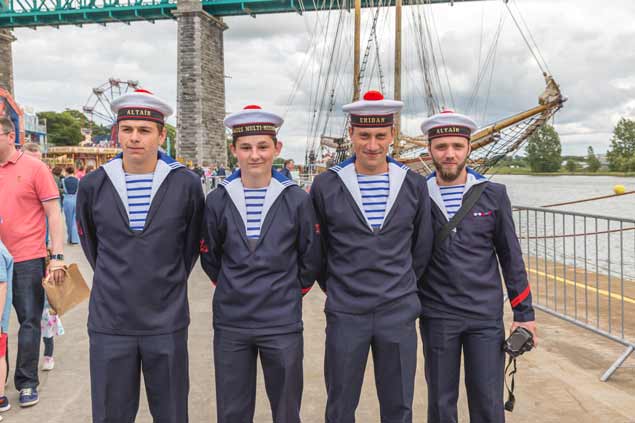
The Festival closed on Sunday evening with the second crew of trainees coming aboard The Brian Boru. The award-winning Drogheda Sail Training Bursary each year offers 20 local young people the life-changing opportunity to learn to sail. The first crew departed on 10th June and sailed into Drogheda on Friday as part of the Irish Maritime Festival. The second crew depart Monday 18th and head north for Warrenpoint, Portaferry, Ardglass and Kilkeel before returning to Drogheda.
The festival may be over for another year, but the work continues in Drogheda Port to make the River Boyne an integral part of daily life in the town and an attractive destination for leisure sailors and commercial operators.
Tall Ships Parade of Sail on Dublin Bay
A flotilla of yachts and pleasure craft including sailing dinghies, RIBs and angling craft gathered off Dun Laoghaire Harbour today to wish Bon Voyage to 16 Tall Ships who visited Dublin Bay over the Bank Holiday weekend and are now en route to France.
As Afloat.ie reported earlier, a Parade of Sail of Tall Ships came down the River Liffey and out into Dublin Bay under full sail in light winds to be the final spectacle in a festival that has attracted an estimated 100,000 visitors to the Port area over the 4-day stopover in Dublin.
Organised by Sail Training International the stopover in Dublin was hosted by Dublin City Council, Waterways Ireland & Dublin Port Company. 450 crew, 50 of whom were Irish trainees, took part in GAA games, Water kayaking, paddle boarding, as well as turning their boats out in ship shape for public visits.
"Up to 100,000 visitors came into Dublin Docklands; Grand Canal Dock and Sir John Rogersons Quay"
Up to 100,000 visitors came into Dublin Docklands; Grand Canal Dock and Sir John Rogersons Quay to visit the splendid ships over Saturday and Sunday.
With temperatures soaring, visitors enjoyed free public tours of the ships, street animation and got to know their capital city a little better.
See our gallery of Tall Ship Photos departing Dublin below:
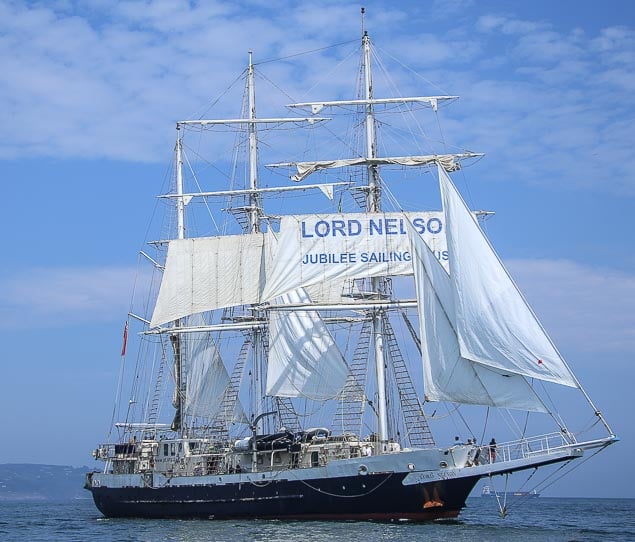 Tall Ship Lord Nelson Photo: Afloat.ie
Tall Ship Lord Nelson Photo: Afloat.ie
 Tall Ship Belle Poule Photo: Afloat.ie
Tall Ship Belle Poule Photo: Afloat.ie
 Tall Ship DeGallant Photo: Afloat.ie
Tall Ship DeGallant Photo: Afloat.ie
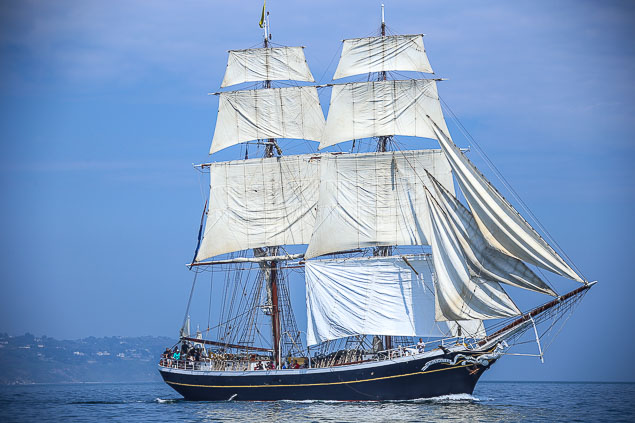 Tall Ship Morgenster Photo: Afloat.ie
Tall Ship Morgenster Photo: Afloat.ie
 Tall Ship Maybe Photo: Afloat.ie
Tall Ship Maybe Photo: Afloat.ie
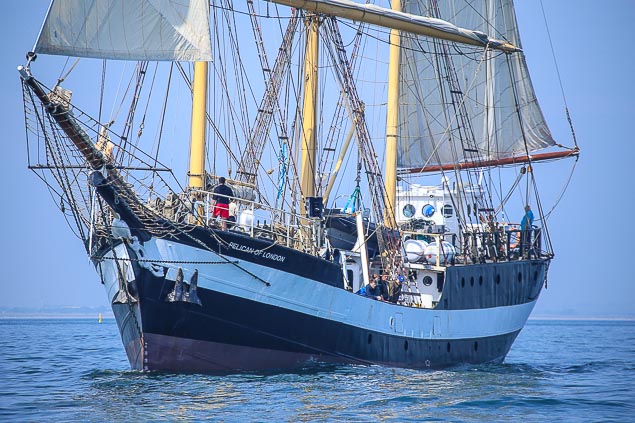 Tall Ship Pelican of London Photo: Afloat.ie
Tall Ship Pelican of London Photo: Afloat.ie
 Tall Ship Johanna Lucretia Photo: Afloat.ie
Tall Ship Johanna Lucretia Photo: Afloat.ie
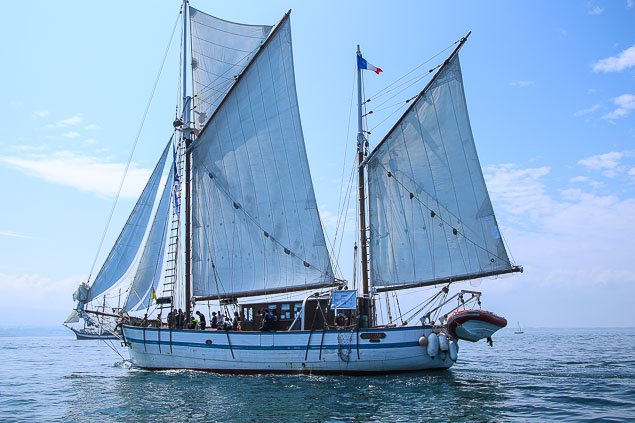 Tall Ship Arawak Photo: Afloat.ie
Tall Ship Arawak Photo: Afloat.ie
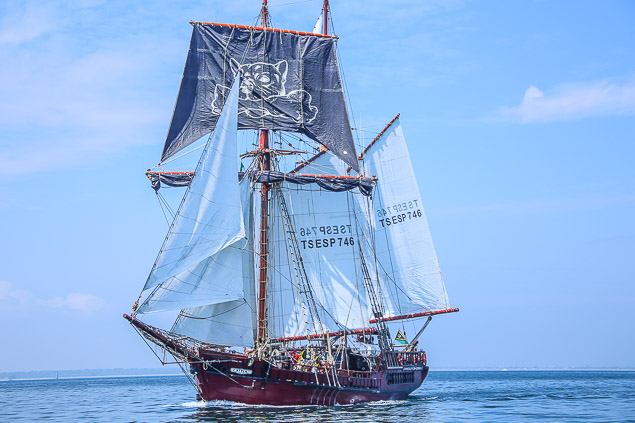 Tall Ship Atyla Photo: Afloat.ie
Tall Ship Atyla Photo: Afloat.ie


























